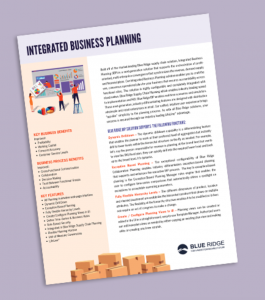 Right now, as you read this, the majority of inventory optimization efforts are happening in silos. Why???
Right now, as you read this, the majority of inventory optimization efforts are happening in silos. Why???
There’s no need for it.
In this day and age of real-time collaboration and predictive automation technologies, inventory optimization should be a seamless activity that envelopes the vital business goals and strategies of all departments.
Integrated Business Planning (IBP), often referred to as Sales and Operations Planning (S&OP), brings huge benefits to a company’s inventory optimization efforts. IBP is the next generation of enterprise-wide synchronization and supply chain agility. Get IBP, or get left behind in today’s highly disruptive market.
Today I want to look at 6 benefits that implementing IBP can bring to your business:
#1: Easily manage fluid data
Inventory levels are fluid by nature and subject to constant change. IBP gives you instant, up-to-the-minute access to data so you can perform dynamic inventory optimization, demand planning and supply planning. Static historical data about future inventory needs is a bust in today’s chaotic supply chain environment.
#2: Simpler data collection and analysis
If you’re using older technology – or a one-size-fits-all ERP or WMS solution’s planning module – to support S&OP, your team is probably spending loads of time on clerical B.S., such as pulling data manually from spreadsheets and third-party applications, and trying to organize it into Excel. And for what??? More wasted time spent analyzing it.
IBP provides a single, cloud-based tool to easily collect data for super-quick analysis.
#3: Flexible planning horizon
IBP synchronizes the revenue, demand and supply financial plans so you can craft the one, consensus operational plan for your business that ensures accountability across functional silos. In minutes or seconds, instead of days or weeks.
You can easily extract and load data from a variety of formats. IBP provides “app-like simplicity”, rather than a confusing collection of tables where only the admins can make sense of the reports and data you need.
Using a dynamic drilldown feature, the demand planner can work at their preferred level of aggregation but instantly drill to lower levels within the hierarchical structure on the fly as needed.
#4: Streamline exceptions management
An IBP solution like Blue Ridge allows exception-based planning with time-series and business rules that support and enhance the executive IBP process.
The key to exception-based planning is the Exception-Based Planning Manager rules engine, which enables the user to configure time-series comparisons that automatically shine a spotlight on exceptions to acceptable operating parameters. This is a huge advantage in decision making and creating trust between functional groups.
#5: Cross-functional collaboration
Act faster as a unified organization. With IBP, the different dimensions of product, location and channel (customer) are enabled in the hierarchical construct that draws on multiple attributes.
The flexibility of the hierarchy structure enables demand planners to modify it, so it does not require an act of Congress to make a change. Changes can be communicated in real time to other departments, suppliers and end-customers to act/respond faster, eliminate finger pointing and manage expectations.
#6: Rapid installation
The best IBP solution should include a Services team to not only accelerate implementation, but proactively be your lifeline to ongoing success.
Does the vendor have a dedicated team to monitor your supply chain analytics beyond basic reporting to ensure continuous improvement day-by-day, month-by-month, year-by-year – when you don’t have the time to?
Blue Ridge does. Learn more about Integrated Business Planning (IBP):














